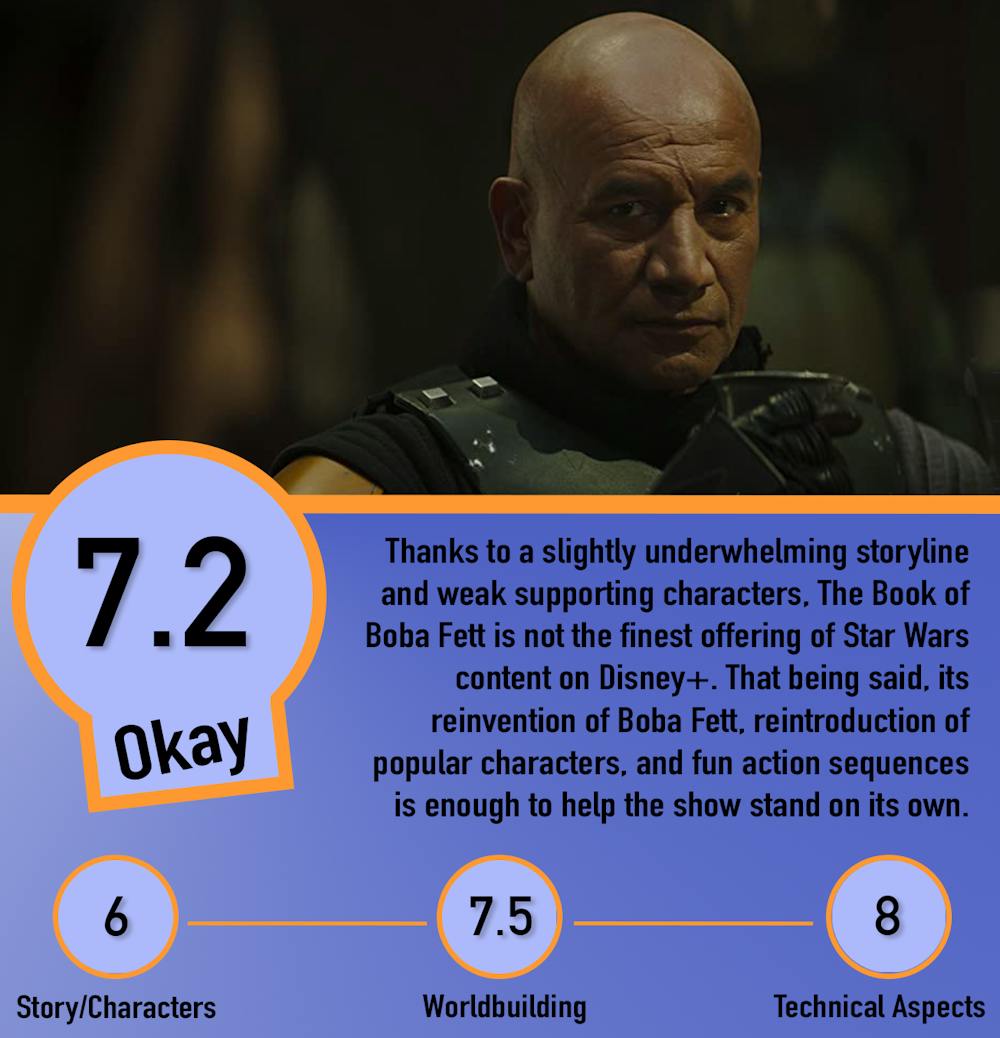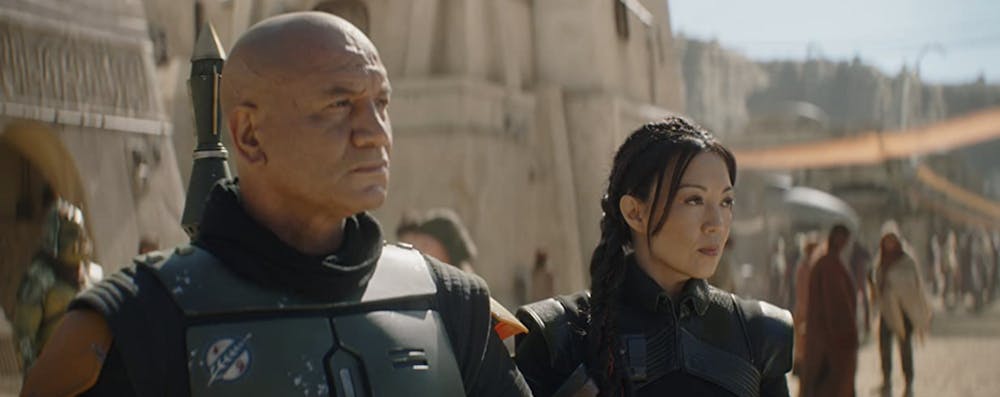NOTE: There are spoilers present throughout
In late 2020, the second season of The Mandalorian began streaming on Disney+, returning viewers to the adventures of Din Djarin (Pedro Pascal) and his adopted son, Grogu. At the end of the first episode—titled Chapter 9: The Marshal—a mysterious figure was shown to be watching the pair ride off into the sunset: former bounty hunter Boba Fett (Temuera Morrison). However, unlike previous portrayals of the character, Fett was missing his iconic Mandalorian armor and looked more grizzled and tired than ever before. He returned with fellow bounty hunter Fennec Shand (Ming-Na Wen, who reprised her role from season 1) later in the season to help Djarin rescue Grogu from Imperial commander, Moff Gideon (Giancarlo Esposito).
In the second season’s after-credits scene, it was revealed that Fett and Shand teamed up and took control of deceased crime lord Jabba the Hutt’s palace on Tatooine. The scene ends with a title card labeled “The Book of Boba Fett”, apparently for a show that was coming in December 2021. Lo and behold, that is exactly what happened: labeled as The Mandalorian season 2.5, the 7-episode season premiered on December 29th, 2021 and ended on February 9th, 2022. While thoroughly entertaining—with some fan-pleasing moments thrown into the mix—The Book of Boba Fett didn’t reach the heights of its predecessor.
To Live or Die in Mos Espa
The show begins shortly after Fett and Shand’s ascension, with the former slowly transitioning into a daimyo. Fett—with Shand as his right-hand woman—frequently travels to the nearby spaceport of Mos Espa to establish connections amidst the criminal underworld. The first four episodes depict Fett’s initial struggles and triumphs, in which he and Shand gain allies, but also uncover a sinister plot. An organization known as the Pyke Syndicate is using Tatooine to smuggle a drug known as “spice,” and it is harming the planet.
Fett is the clear focal point during these episodes, where he’s given a level of depth and complexity that the character didn’t have before. (In previous appearances, Fett was simply a ruthless bounty hunter that barely spoke and who was nearly killed by a half-blind Han Solo in Return of the Jedi). The newfound strength granted to the character gives Morrison time to shine, playing Fett with a quiet sense of determination along with a dry sense of humor. The second episode—Chapter 2: The Tribes of Tatooine—is the best example of this, focusing entirely on Fett’s rebirth after escaping the sarlacc pit. He is saved by a tribe of Tusken Raiders, and the connection between Fett and the tribe is a powerful one, culminating in a beautiful sequence in which they accept him as one of their own.
Unfortunately, the supporting characters and antagonists don’t have the same weight. While Wen gives a playful charm to Shand, the character herself has little to no growth whatsoever. She only grows from being a ruthless bounty hunter to a ruthless right-hand woman. The other characters—such as a cowardly majordomo and a group called the “Mods”—also suffer, either being annoying (thanks to weak jokes told on the majordomo’s part) or simply being there to look cool (thanks to the Mods’ robotic ‘modifications’). The Pyke Syndicate experience the greatest brunt of this, being completely forgettable and unthreatening as antagonists. They serve nothing more as cannon fodder for Fett, Shand, and the others to shoot, and that is it. This show sorely needed its equivalent to Moff Gideon, who had his own ulterior motives and personality.
The Mando with No Name
As the story truly starts to kick into high gear, something happens that changes its trajectory. Din Djarin himself returns in the fifth episode, aptly-titled Chapter 5: Return of the Mandalorian. Rather than having Djarin already be on Tatooine in time to help Fett and Shand fight the Pykes, the episode instead acts as a sort of bridge between the second and third seasons of The Mandalorian. Djarin is shown to have regressed back into being a cold-hearted bounty hunter, no longer acting as Grogu’s caregiver.
Despite that, the emotional core of Djarin’s character is present. He misses his son greatly, and Pascal is still able to capture that perfectly—a notable feat considering that the character is wearing a helmet. The episode, while jarring, helps catch the viewer up on what Djarin has been up to and establish him within the show’s narrative.
That being said, the following episode—Chapter 6: From the Desert Comes a Stranger—is an unusual one. While it progresses the show’s plot through reintroducing Cobb Vanth and Freetown from The Mandalorian, a large portion of the episode doesn’t pertain to the conflict with the Pyke Syndicate at all. Instead, it is dedicated to Grogu’s Jedi training under Luke Skywalker (who looks remarkably like a younger Mark Hamill; a large improvement over the questionable CGI used for him in The Mandalorian). While seeing Luke train Grogu was great to witness—laying the foundation for Skywalker’s portrayal in the sequel trilogy—it felt like it belonged to an entirely different show altogether. At times, viewers might have to remind themselves that they are watching a show about Boba Fett and not Luke Skywalker and his young Jedi pupil.
Fortunately, the finale—Chapter 7: In the Name of Honor—returns to the Pyke storyline, with Fett front and center once again. The episode is one gigantic roller coaster, filled with a Fett-and-Djarin action sequence, Fett riding a rancor and massive crab-like droids. While certain parts feel unnecessary, like the “comedic” bits involving the majordomo, the finale stuck the landing for the most part.
You Cad Me at “Hello”
The technical aspects of The Book of Boba Fett are worth discussing, as it is perhaps the best we’ve seen in the Star Wars live-action shows. The makeup and creature effects are truly impressive to behold, particularly that of the Tusken tribe that sheltered Fett and that of Cad Bane, who makes his first live-action appearance in the show.
The vistas of Tatooine, while overused, look fantastic, with Mos Espa being the standout. Rather than the cramped spaceport that viewers saw in The Phantom Menace, Espa has been fully transformed into a massive city (which makes sense in-universe, as it has been decades since the events of that film). Other, unnamed planets also make appearances, with the notable highlight being that of this massive, ringed space station that viewers have compared to a similar location from Halo.
Additionally, the show’s soundtrack is well-crafted by Joseph Shirley and Ludwig Göransson—who also worked on The Mandalorian. The pair do a great job in creating a Western-sounding feel to Fett’s story, further evoking one of the many influences of Star Wars. Göransson’s main theme for Fett is especially fantastic, and it might just reach the iconic status that his theme for The Mandalorian has.

Sources: IMDb, IMDb, thewrap.com, IMDb, hitc.com
Contact Anthony Herring with comments at ajherring@bsu.edu.




















